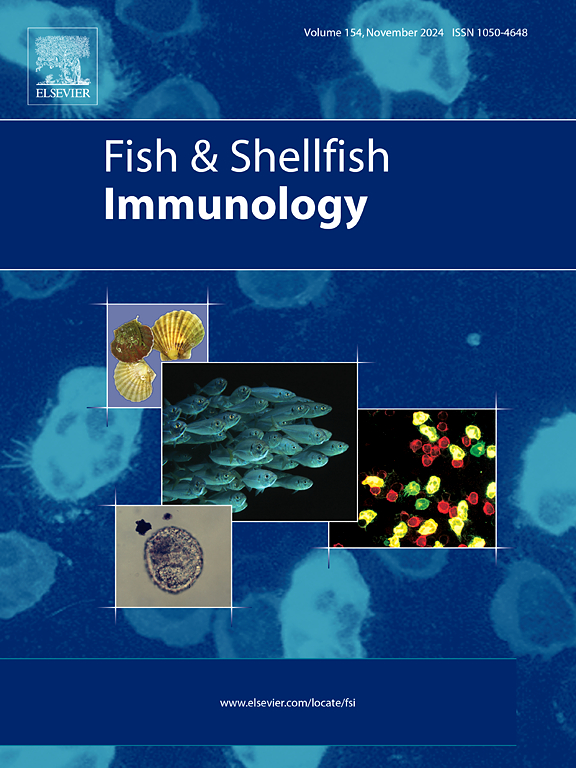FADD cooperates with Caspase-8 to positively regulate the innate immune response and promote apoptosis following bacterial infection in Japanese eel
IF 4.1
2区 农林科学
Q1 FISHERIES
引用次数: 0
Abstract
Fas-associated protein with Death Domain (FADD) is a crucial signaling component of apoptosis and a vital immunomodulator on inflammatory signaling pathways. However, information on FADD-mediated apoptosis and immune regulation is limited in teleost. We herein cloned a FADD homolog, AjFADD, from Japanese eel (Anguilla japonica). Expression analysis revealed that AjFADD was significantly induced by LPS, poly I:C, and Aeromonas hydrophila infection in vivo and in vitro. The expression of IFNs and IRFs, c-Rel and c-Fos, IL1 and TNF-α, and the essential antimicrobial peptide LEAP-2 in Japanese eel liver cells was enhanced by overexpressing AjFADD, with a significant decrease of those genes following knockdown AjFADD. Luciferase activity assay, flow cytometry, and wound healing results showed that AjFADD cooperated with AjCaspase-8 to promote apoptosis of HEK293 cells and Japanese eel liver cells infected with A. hydrophila. Furthermore, AjFADD and AjCaspase-8 co-localized in the cytoplasm and displayed a direct protein-protein interaction by immunoprecipitation. Our results collectively showed that FADD cooperated with Caspase-8 to positively regulate the innate immune response and promote apoptosis in response to the A. hydrophila challenge in Japanese eel.

FADD与Caspase-8协同正向调节日本鳗鲡细菌感染后的先天免疫反应,促进细胞凋亡。
fas相关蛋白与死亡结构域(FADD)是细胞凋亡的重要信号成分,也是炎症信号通路的重要免疫调节剂。然而,关于fadd介导的硬骨鱼细胞凋亡和免疫调节的信息有限。本文从日本鳗鲡(Anguilla japonica)中克隆了一个FADD同源基因AjFADD。表达分析表明,体内外AjFADD均受LPS、poly I:C和嗜水气单胞菌感染的显著诱导。过表达AjFADD后,日本鳗鲡肝细胞中p65、c-Rel、c-Jun、c-Fos、IL1、IL6和必需抗菌肽LEAP-2的表达增强,而敲低AjFADD后,这些基因的表达显著降低。荧光素酶活性测定、流式细胞术及伤口愈合结果显示,AjFADD与AjCaspase-8协同作用可促进HEK293细胞及嗜水单胞菌感染的日本鳗鲡肝细胞凋亡。此外,AjFADD和AjCaspase-8在细胞质中共定位,并通过免疫沉淀表现出直接的蛋白相互作用。综上所述,FADD与Caspase-8共同作用,正向调节日本鳗鲡对嗜水拟南鳗的先天免疫反应,促进细胞凋亡。
本文章由计算机程序翻译,如有差异,请以英文原文为准。
求助全文
约1分钟内获得全文
求助全文
来源期刊

Fish & shellfish immunology
农林科学-海洋与淡水生物学
CiteScore
7.50
自引率
19.10%
发文量
750
审稿时长
68 days
期刊介绍:
Fish and Shellfish Immunology rapidly publishes high-quality, peer-refereed contributions in the expanding fields of fish and shellfish immunology. It presents studies on the basic mechanisms of both the specific and non-specific defense systems, the cells, tissues, and humoral factors involved, their dependence on environmental and intrinsic factors, response to pathogens, response to vaccination, and applied studies on the development of specific vaccines for use in the aquaculture industry.
 求助内容:
求助内容: 应助结果提醒方式:
应助结果提醒方式:


